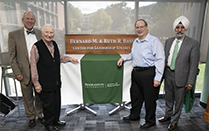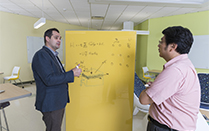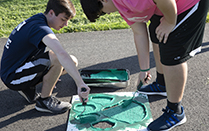
IMPROVING CAMPUS INFRASTRUCTURE
Some of the major improvements to infrastructure completed over the summer are very visible; others are not. Read in this issue about the many major projects completed by Physical Facilities and Information Technology Services, as well as the new programs offered by the University Center for Training and Development.

SCHOOL OF PHARMACY AND PHARMACEUTICAL SCIENCES OPENS NEW BUILDING
The opening of the new, $60-million School of Pharmacy and Pharmaceutical Sciences at the University's Health Sciences Campus in Johnson City, N.Y., headlines this quarterly report, but there's also good news about collaborations, external funding and student successes. Read more in this issue.

SUCCESSFUL INITIATIVES SUPPORT STUDENTS
It takes donors at many levels to make Binghamton University successful, and in this issue of the quarterly report, you can read about a number of them. Whether it's AVANGRID offering full-tuition scholarships and capstone project support, or playing golf to benefit the Alumni Legacy Scholarship, the Division of Advancement works with Binghamton supporters.

BINGHAMTON RESEARCH FUNDING SETS RECORD
Binghamton University reported research expenditures totaling $47.5 million in 2017-18, an increase of about 19 percent from the previous fiscal year. The figure tops 2011-12, the campus’ all-time best year for research funding, when just over $40 million was reported. The new record, which follows several years of steady growth, is an important sign of the campus’ creativity and innovation. Healthcare research accounted for nearly a third of expenditures, with electronics packaging and systems engineering following at about 22 percent.

BAXTER THE BEARCAT BOOSTS SCHOOL SPIRIT
The Division of Student Affairs spent the summer hosting students and families for orientation and preparing for the opening of the fall semester. With some new people on board and some others with new duties, it has been a busy time. Not too busy, though, to show Binghamton University pride, as you'll read about the new Baxter the Bearcat Bench in the University Union in this issue.

STUDENT-ATHLETES CONTINUE TO SUCCEED ACADEMICALLY
Student-athletes continue to shine on and off the courts and fields. The Athletics Department sets high academic standards, and student-athletes surpass them across the board. Read about the accomplishments made by student-athletes in their sports and in the classroom – and check out the videos showcasing fall sports and the new women's head basketball coach, Bethann Shapiro Ord, in this issue.

HELPING TO MAKE THE CAMPUS MORE INCLUSIVE
The Division of Diversity, Equity and Inclusion works to educate and empower everyone on campus in ways that create a welcoming community. From the Udiversity Educational Institute, that holds trainings for students, faculty and staff, to the Multicultural Resource Center and Q Center, the division's offices that work to build bridges and support students though education and events such as Sundaze, part of its Welcome Week programming. Read about the division's recent initiatives in this report.

DONOR SUPPORT ADVANCES BINGHAMTON UNIVERSITY
The Binghamton University Foundation had a successful 2017-18 year, bringing in the second highest amount of cash ever in support of the University. Read the numbers in this issue of the quarterly report, and learn one way the Foundation celebrates its donors.
University rethinks calculus instruction—with positive results
When it comes to teaching calculus, Binghamton University could have been compared to most other campuses around the country – until now, that is. Recent changes to the way the campus prepares students in the challenging subject could soon be a model for others to follow.
The biggest issue observed by both calculus instructors and those who teach courses where calculus is a required skill is this: students often arrive on campus without the pre-calculus skills required to succeed.
“Some students need more background and to fill holes in their background,” said William Kazmierczak, hired as director of calculus in 2014. “It’s not the calculus they necessarily have trouble with, but rather the pre-calculus and the pre-calculs skills needed to solve calculus problems. They’re missing steps from pre-calc to calc and that gets huge later on when they don’t have that foundation.”
Since Kazmierczak came on board, a pilot program has been expanded so that all beginning calculus classes are now flipped, using technology to push introductory material to students, freeing their class time for coached, group sessions and active learning. Improvement in student learning was seen, but that was just the beginning.
“We had already made significant progress with the calculus pathway,” said Donald Loewen, vice provost for undergraduate education and enrollment. “But we wanted to think about how to segment classes a bit more to allow students to catch up if they get behind – to give them a softer landing you might say.”
Results already in show that the percentage of students who receive a D, F or who withdraw from Calculus I have fallen from 19 percent in 2014 to 10 percent in 2015, and in Calculus II have fallen from 36 percent in 2014 to 14 percent in 2015.